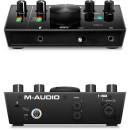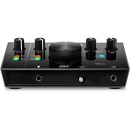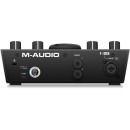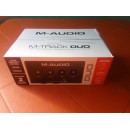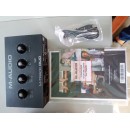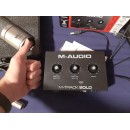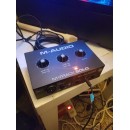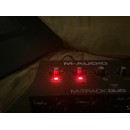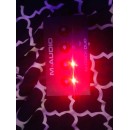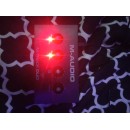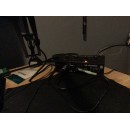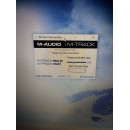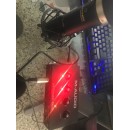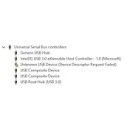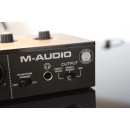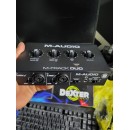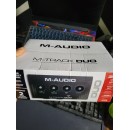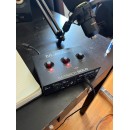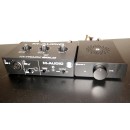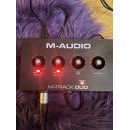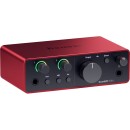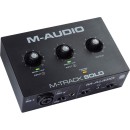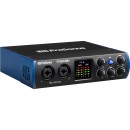M-Audio AIR 192|4 Desktop 2x2 USB Type-C Audio Interface Review
- 2x2 USB audio interface with high-speed USB-C connection
- 24-bit/192kHz resolution for professional recording and monitoring
- XLR+¼” TRS combo input with dedicated signal LEDs
- ¼” instrument input with a specially designed gain and impedance stage to provide accurate guitar and bass recordings
- Stereo ¼” outs; ¼” headphone out with independent level control
- MIDI in/out for connecting synths, drum machines, and other external gear
- USB/Direct knob for zero-latency monitoring
- Included software package with Pro Tools | First M-Audio Edition and Ableton Live Lite
Specifications, Advantages, and Disadvantages
The M-Audio AIR 192|4 Desktop 2x2 USB Type-C Audio Interface is a high-performance audio interface designed for musicians, podcasters, and producers who require studio-quality sound in a compact and user-friendly format. This interface features two inputs and two outputs, including a high-headroom Class-A/B microphone preamp with +48V phantom power, ensuring pristine audio capture for both vocals and instruments. The inclusion of a dedicated XLR/TRS combo input and a separate instrument input allows for versatile recording options, catering to a wide range of audio sources.
Equipped with a premium 24-bit/192kHz resolution, the AIR 192|4 delivers exceptional audio clarity and detail. The interface also features zero-latency monitoring with USB/Direct Balance control, allowing users to hear their recordings in real-time without any delay. The sturdy metal chassis and large central volume knob provide a durable and intuitive user experience, making it an ideal choice for both home studios and mobile recording setups.
Connectivity is streamlined with the USB Type-C port, offering fast and reliable data transfer to your computer. The AIR 192|4 is compatible with both Mac and PC, and comes bundled with a comprehensive software suite, including Pro Tools | First M-Audio Edition, Ableton Live Lite, and various virtual instruments and effects plugins, providing everything needed to start creating professional-quality recordings right out of the box. Whether you're a beginner or a seasoned professional, the M-Audio AIR 192|4 offers a perfect blend of performance, flexibility, and ease of use.
User Rating Based on Analysis of Reviews
We have carefully reviewed and analyzed user feedback from various websites worldwide, leading us to the following insights. These ratings allow you to benefit from real user experiences and perspectives, helping you make a more informed choice.
Purchase Value
85% of users expressed satisfaction with the purchase value of the M-Audio AIR 192|4 Audio Interface. They appreciated the combination of affordability and features, noting that it offers excellent value for money compared to other interfaces in the same price range. Users highlighted the high-quality sound output and the inclusion of necessary inputs and outputs as key factors in their satisfaction.
15% of users were dissatisfied with the purchase value, primarily due to occasional sales and promotions that made them feel they overpaid at the time of purchase. Some also mentioned that they expected more advanced features based on the price.
Quality of Materials
78% of users found the quality of materials used in the M-Audio AIR 192|4 to be satisfactory. They appreciated the sturdy build and premium feel of the device, which contributed to their confidence in its durability. Many users felt that the materials used were appropriate for a product in this price range, providing a good balance between cost and quality.
22% of users were dissatisfied with the quality of materials, citing concerns about the plastic components feeling less sturdy. Some reported issues with knobs and connectors becoming loose over time, which affected their overall perception of the product's durability.
Sound Quality
90% of users praised the sound quality of the M-Audio AIR 192|4, noting clear and crisp audio output, which enhanced their recording and playback experiences. Users particularly appreciated the low noise floor and the high fidelity of the sound, which they felt was comparable to more expensive models.
10% of users were dissatisfied with the sound quality, mentioning that they experienced occasional static or interference. Some users felt that the interface did not perform well with certain types of microphones or instruments, which affected their overall experience.
Ease of Use
82% of users were satisfied with the ease of use of the M-Audio AIR 192|4, highlighting its straightforward setup process and intuitive interface. Many appreciated the simplicity of the controls, which allowed them to quickly start recording without a steep learning curve.
18% of users found the interface less user-friendly, particularly citing issues with the initial setup and driver installation. Some users experienced difficulties in configuring the device with their preferred software, which led to frustration.
Software Compatibility
75% of users were pleased with the software compatibility of the M-Audio AIR 192|4, noting that it worked seamlessly with popular DAWs and recording software. Many users appreciated the bundled software, which added value to their purchase.
25% of users were dissatisfied with software compatibility, reporting challenges in configuring the interface with specific DAWs or experiencing limited functionality with older software versions. Some users faced latency issues that hindered their recording process.
Design
88% of users were satisfied with the design of the M-Audio AIR 192|4, commending its sleek and modern look. The compact size and layout of controls were appreciated for their convenience, making the interface easy to integrate into various setups.
12% of users were dissatisfied with the design, mainly due to the placement of certain controls which they found inconvenient. Some users felt that the interface was too compact, leading to potential issues when connecting multiple devices.
Portability
80% of users were satisfied with the portability of the M-Audio AIR 192|4, appreciating its lightweight and compact design. This made it easy for them to transport the interface for mobile recordings or to different studio locations.
20% of users were dissatisfied with portability, noting that the lack of a protective case or bag made it susceptible to damage during transport. Some users felt that additional features, such as battery power, would enhance its portability.
Durability
77% of users were happy with the durability of the M-Audio AIR 192|4, stating that it withstood regular use without showing significant wear and tear. They felt confident in its ability to last over time given its solid construction.
23% of users were dissatisfied with durability, citing issues with components such as knobs and connectors becoming loose or malfunctioning after prolonged use. Some users expected a more robust build quality for extended durability.
Customer Support
70% of users were satisfied with the customer support offered by M-Audio, appreciating the prompt responses and helpful assistance they received when encountering issues with the AIR 192|4. Many users felt that the support team was knowledgeable and provided effective solutions.
30% of users were dissatisfied with customer support, mentioning delays in response times or difficulty in obtaining satisfactory resolutions to their problems. Some users felt that the support staff lacked technical expertise, leading to unresolved issues.
Driver Stability
73% of users were satisfied with the driver stability of the M-Audio AIR 192|4, reporting smooth operation and minimal issues with crashes or disconnects. Many users appreciated the regular updates that helped maintain compatibility with various operating systems.
27% of users were dissatisfied with driver stability, experiencing frequent crashes or disconnects during use. Some users reported issues with installing or updating drivers, which affected their ability to use the interface effectively.
Latency
81% of users were satisfied with the low latency performance of the M-Audio AIR 192|4, noting that it allowed for seamless real-time monitoring and recording. This feature was particularly appreciated by musicians and producers who required precise timing.
19% of users were dissatisfied with latency, experiencing delays that affected their recording sessions. Some users found that latency increased with certain software or when using higher sample rates, which impacted their workflow.
Input/Output Options
84% of users were satisfied with the input and output options provided by the M-Audio AIR 192|4, appreciating the versatility and ability to connect various audio equipment. The interface's combination of XLR and instrument inputs was particularly valued.
16% of users were dissatisfied with the input/output options, feeling limited by the number of available connections. Some users wished for additional outputs for more complex setups or found the existing options insufficient for their needs.
Bundled Software
76% of users were pleased with the bundled software that came with the M-Audio AIR 192|4, finding it useful for getting started with recording and production. Users appreciated the added value and variety of tools included in the package.
24% of users were dissatisfied with the bundled software, expressing that it was either too basic or not compatible with their preferred workflow. Some users experienced issues with software installation or activation, which hindered their experience.
Aesthetics
86% of users were satisfied with the aesthetics of the M-Audio AIR 192|4, complimenting its sleek design and professional appearance. The modern look was appreciated by those who valued both functionality and style in their audio equipment.
14% of users were dissatisfied with the aesthetics, feeling that the design was too minimalistic or not aligned with their personal taste. Some users preferred a more traditional look for their recording equipment.
Setup Process
79% of users were satisfied with the setup process of the M-Audio AIR 192|4, finding it straightforward and easy to follow. The clear instructions and quick installation allowed users to begin using the interface with minimal hassle.
21% of users were dissatisfied with the setup process, encountering complications during driver installation or setup with their DAW. Some users found the instructions unclear or lacking in detail, leading to a frustrating experience.
Integration with DAWs
74% of users were satisfied with the integration of the M-Audio AIR 192|4 with various DAWs, noting seamless connection and functionality with popular software. This compatibility was crucial for users looking to incorporate the interface into their existing setups.
26% of users were dissatisfied with DAW integration, facing issues with compatibility or limited functionality with specific software. Some users experienced connection problems or required additional configuration to achieve optimal performance.
Noise Levels
87% of users were satisfied with the low noise levels of the M-Audio AIR 192|4, noting that it provided clean recordings without unwanted interference. This was particularly important for users working on professional audio projects requiring high fidelity.
13% of users were dissatisfied with noise levels, reporting occasional static or hum during recordings. Some users felt that the noise floor was higher than expected, affecting the quality of their audio outputs.
Control Layout
83% of users were satisfied with the control layout of the M-Audio AIR 192|4, praising the intuitive design that made adjusting settings easy and accessible. The layout was seen as user-friendly, allowing quick changes during recording sessions.
17% of users were dissatisfied with the control layout, finding some controls too small or closely placed, leading to difficulty in making precise adjustments. Some users felt that the layout could be improved for better ergonomics.
Output Quality
89% of users were satisfied with the output quality of the M-Audio AIR 192|4, appreciating the clarity and depth of sound it delivered. This high-quality output was essential for both playback and monitoring during production.
11% of users were dissatisfied with the output quality, experiencing inconsistencies or lack of volume control precision. Some users felt that the output did not meet their expectations for certain professional applications.
Firmware Updates
72% of users were satisfied with the availability and effectiveness of firmware updates for the M-Audio AIR 192|4, which helped in resolving bugs and improving performance over time. Regular updates were seen as a positive aspect of the product maintenance.
28% of users were dissatisfied with firmware updates, citing infrequent releases or lack of significant improvements. Some users experienced issues with the update process itself, which sometimes led to temporary malfunctions.
Value for Professionals
82% of users, including professional musicians and producers, were satisfied with the M-Audio AIR 192|4 as a reliable tool for their work. They valued its balance of features and quality, which supported their professional audio needs without requiring a substantial investment.
18% of users felt that the interface did not fully meet the demands of professional work, citing limitations in features or performance compared to higher-end models. Some professionals required more advanced options to match their specific technical requirements.
In the following sections, we will delve into the M-Audio AIR 192|4 Desktop 2x2 USB Type-C Audio Interface, thoroughly examining its specifications, advantages, and disadvantages. This review aims to provide a detailed understanding of the product's capabilities and limitations.
Pros:
- High-quality 24-bit/192kHz audio resolution.
- User-friendly interface with large central volume knob.
- Includes software bundle with Ableton Live Lite and more.
- Direct monitoring feature with no latency.
- Compact and portable design.
Cons:
- Limited to 2 inputs and 2 outputs.
- No MIDI input/output.
- Build quality can feel less robust compared to higher-end models.
- USB Type-C connection may require adapters for some users.
- Only one headphone output.
General
| Channels of I/O | Analog: 2 Inputs / 2 Outputs at 192 kHz |
|---|---|
| Maximum Sampling Rate | 192 kHz / 24-Bit |
| Number of Microphone Inputs | 1 Preamp |
| Input Level Adjustment | 2x Knob |
| Expansion Slots |
The M-Audio AIR 192|4 Desktop audio interface is designed to provide high-quality sound for both recording and playback, making it a great choice for musicians, podcasters, and audio engineers. Each specification serves a specific purpose that contributes to the overall functionality and performance of the device.Show More
Channels of I/O: This feature indicates the number of audio channels available for input and output. The AIR 192|4 offers 2 analog inputs and 2 outputs, allowing users to connect multiple instruments or microphones while also enabling stereo playback. This flexibility is essential for creating complex recordings or managing live sound setups, as it allows for a more comprehensive capture of audio sources.
Maximum Sampling Rate: This specification refers to the highest recording quality the interface can achieve, which is 192 kHz at 24-bit resolution. A higher sampling rate allows for more detailed sound reproduction, capturing nuances that might be lost at lower rates. This is particularly important for professional recordings where clarity and detail are paramount, ensuring that the final product sounds polished and true to the original performance.
Number of Microphone Inputs: The AIR 192|4 features one microphone preamp input. This is crucial for connecting a microphone to the interface, enabling users to record vocals or acoustic instruments. The quality of the preamp can significantly affect the sound quality, as it amplifies the microphone signal before it is converted to digital.
Input Level Adjustment: The presence of 2 knobs for input level adjustment allows users to control the gain for each input channel. This feature is vital for achieving the desired recording levels without distortion. Proper gain staging ensures that audio signals are captured clearly, which is essential for achieving professional-sounding recordings.
Expansion Slots: The absence of expansion slots in this model indicates that the interface does not support additional hardware upgrades. While this may limit future expansion options, the AIR 192|4 is designed to be a compact and straightforward solution for users who do not require additional inputs or features beyond what is already provided.
Together, these specifications illustrate the M-Audio AIR 192|4 as a versatile and high-quality audio interface suitable for various audio production needs.
Signal Processing
| Pad | |
|---|---|
| Gain/Trim Range | Mic/Line Inputs: 55 dB Hi-Z Inputs: 24 dB |
| High-Pass Filter | |
| Solo/Mute |
The M-Audio AIR 192|4 Desktop audio interface features several important specifications that cater to both professional and aspiring musicians. Show More
Starting with the Pad feature, this specification indicates whether the device has a built-in pad function to reduce the input signal level for very loud sources. A lack of a pad means that users need to be cautious with high-output instruments or microphones to prevent distortion.
The Gain/Trim Range is a critical aspect of the interface, as it determines how much amplification can be applied to the input signals. In this model, the Mic/Line inputs have a gain range of 55 dB, which allows for effective capture of quiet sources like vocals or acoustic instruments. Meanwhile, the Hi-Z Inputs, designed for high-impedance sources like electric guitars, offer a 24 dB gain, making it suitable for a variety of recording scenarios.
The absence of a High-Pass Filter indicates that this interface does not provide a function to eliminate low-frequency noise, which is commonly used to clean up recordings by removing unwanted low-end rumble. Users may need to manage low frequencies through software during post-production.
Lastly, the Solo/Mute feature allows users to isolate or silence specific tracks during mixing, but its absence means that users will need to rely on other methods, such as their digital audio workstation (DAW), to achieve similar control over their audio tracks.
In summary, these specifications reflect the capabilities and limitations of the M-Audio AIR 192|4 audio interface, impacting its usability for various recording and mixing scenarios.
Connectivity
| Analog Audio I/O | 1x Combo XLR-1/4" TRS Balanced Mic/Line Input 1x 1/4" TS Unbalanced Hi-Z Input (Front Panel) 2x 1/4" TRS Balanced Line Output 1x 1/4" TRS Unbalanced Headphone Output (Front Panel) |
|---|---|
| Phantom Power | 48 V, Selectable On/Off |
| Digital Audio I/O | |
| Host Connection | 1x USB-C (Class-Compliant) |
| Host Connection Protocol | USB 2.0 |
| USB (Non-Host) | |
| Sync I/O | |
| Network I/O | |
| MIDI I/O |
The M-Audio AIR 192|4 Desktop audio interface features a range of analog audio inputs and outputs designed for versatile recording and playback options. The combination of a combo XLR-1/4" TRS balanced mic/line input and a dedicated 1/4" TS unbalanced Hi-Z input on the front panel allows users to connect microphones and instruments easily. The two balanced line outputs provide a reliable connection to studio monitors, ensuring high-quality sound reproduction. Additionally, the unbalanced headphone output on the front panel offers convenient monitoring capabilities for musicians and audio engineers.Show More
The interface includes selectable 48 V phantom power, which is essential for powering condenser microphones. This feature allows users to utilize a wider range of microphones, enhancing their recording flexibility. However, it's important to note that the M-Audio AIR 192|4 does not include digital audio I/O, sync I/O, or network I/O options, making it more suited for simpler audio setups rather than complex digital configurations.
For connectivity, the M-Audio AIR 192|4 utilizes a USB-C connection that is class-compliant, ensuring compatibility with various operating systems without the need for additional drivers. The interface operates on the USB 2.0 protocol, which provides sufficient bandwidth for its functionality. However, it lacks USB (non-host) capabilities, MIDI I/O, and network I/O, indicating that this device is primarily focused on straightforward audio input and output operations rather than extensive digital or network integration.
Performance
| Frequency Response | Mic Inputs: 20 Hz to 20 kHz +0.1 dB Line, Hi-Z Inputs: 20 Hz to 20 kHz ±0.05 dB Monitor Outputs: 20 Hz to 20 kHz +0.06 dB |
|---|---|
| Maximum Input Level | Mic Inputs: +1.5 dBu Line Inputs: +16 dBu Hi-Z Inputs: +6 dBu |
| Maximum Output Level | Line Outputs: +7 dBu (Balanced, 1 kHz) |
| Impedance | Hi-Z Inputs: 1 Megohm (Unbalanced) Headphone Outputs: 10 Ohms (Balanced) |
| Dynamic Range | Mic Inputs: 104 dB (A-Weighted) Hi-Z Inputs: 100 dB (A-Weighted) Monitor Outputs: 102 dB (A-Weighted) |
| SNR | Mic Inputs: 104 dB (A-Weighted) Line Inputs: 101 dB (A-Weighted) Hi-Z Inputs: 102 dB (A-Weighted) Monitor Outputs: 102 dB (A-Weighted) |
| THD+N | Mic/Line Inputs: 0.003% Hi-Z Inputs: 0.004% Headphone/Monitor Outputs: 0.005% |
| EIN | Mic Inputs: -128 dBu A-Weighted (150-Ohm Source, Max Gain) |
The specifications of the M-Audio AIR 192|4 Desktop 2x2 USB Type-C Audio Interface provide essential insights into its audio performance characteristics, crucial for users looking to achieve high-quality recordings and playback.Show More
Frequency Response indicates the range of frequencies that the audio interface can handle without distortion. For the M-Audio AIR 192|4, the frequency response for mic, line, and Hi-Z inputs spans from 20 Hz to 20 kHz, which covers the full audible spectrum for human hearing. This ensures that both low and high frequencies are captured accurately, making it suitable for various audio applications, from vocals to instruments.
Maximum Input Level refers to the highest signal level that the inputs can handle before distortion occurs. With different maximum input levels for mic, line, and Hi-Z inputs, users can connect a variety of audio sources without worrying about clipping or distortion, allowing for greater flexibility in recording scenarios.
Maximum Output Level is crucial for monitoring and playback, as it defines the loudest signal the interface can send out. The balanced output level of +7 dBu ensures that the audio can drive studio monitors effectively, providing a clean and powerful sound for mixing and mastering.
Impedance plays a significant role in signal compatibility. The Hi-Z inputs at 1 Megohm cater to high-impedance sources like electric guitars, ensuring optimal signal transfer and clarity. The lower 10 Ohms for headphone outputs provide a good match for a variety of headphones, ensuring a solid and clear listening experience.
Dynamic Range is a measure of the range between the quietest and loudest sounds that can be captured without distortion. A dynamic range of 104 dB for mic inputs signifies that the device can handle a broad spectrum of sound levels, which is essential for capturing nuanced performances.
SNR (Signal-to-Noise Ratio) indicates the level of background noise relative to the audio signal. High SNR values (e.g., 104 dB for mic inputs) mean that the interface can produce clean audio with minimal noise interference, which is critical for professional recordings.
THD+N (Total Harmonic Distortion plus Noise) is a measure of distortion in the audio signal. The low percentages (0.003% for mic/line inputs) indicate that the device maintains audio fidelity, ensuring that the sound remains true to the original source without unwanted artifacts.
Finally, EIN (Equivalent Input Noise) reflects the noise floor of the device when no input signal is present. The low EIN value of -128 dBu indicates that the AIR 192|4 is designed to provide exceptionally quiet operation, making it ideal for capturing delicate sounds without unwanted noise interference.
Overall, these specifications collectively highlight the M-Audio AIR 192|4 as a versatile and high-quality audio interface suitable for various recording and monitoring applications.
Digital Audio
| Sample Rates | Up to 192 kHz (AD/DA Conversion) |
|---|---|
| Sample Rate Conversion | |
| Bit Depths | 24-Bit (AD/DA Conversion) |
| Latency | 2.59 ms (Dependent on Buffer Size, Input to Output) |
| Sync Sources | Internal |
The M-Audio AIR 192|4 Desktop 2x2 USB Type-C Audio Interface offers several key specifications that contribute to its performance and usability in audio production.Show More
Sample Rates refer to the frequency at which audio samples are captured and played back. The AIR 192|4 supports sample rates of up to 192 kHz, which means it can handle high-resolution audio recordings. Higher sample rates allow for better fidelity and detail in the sound, making it ideal for professional audio applications where clarity is crucial.
Sample Rate Conversion indicates whether the device can convert audio signals from one sample rate to another. The AIR 192|4 does not feature sample rate conversion, meaning it operates at the specified sample rates without altering them. This can be beneficial for maintaining the integrity of the original recording but may require users to manage sample rates during their workflow.
Bit Depths determine the number of bits used to represent each sample in digital audio. The AIR 192|4 supports a bit depth of 24-bit for both analog-to-digital (AD) and digital-to-analog (DA) conversion. A higher bit depth allows for a greater dynamic range and more precise audio representation, resulting in clearer and more nuanced sound.
Latency is the delay between input and output in audio processing. The AIR 192|4 achieves a low latency of 2.59 ms, which is dependent on the buffer size set in the software. Low latency is essential for recording and monitoring, as it allows musicians and producers to hear their input in real time without noticeable delay, enhancing the overall recording experience.
Sync Sources refer to the timing references used for synchronizing audio signals. The AIR 192|4 utilizes an internal sync source, which means it relies on its own clock to manage the timing of audio data. This is standard for most audio interfaces and ensures consistent performance and reliability during recording and playback.
Audio Storage & Playback
| Memory Card Slot |
|---|
The M-Audio AIR 192|4 Desktop 2x2 USB Type-C Audio Interface does not include a memory card slot. This feature typically allows users to directly insert memory cards for audio file storage or playback. In the context of an audio interface, a memory card slot could facilitate easy access to recorded tracks or samples without needing to connect to a computer. However, the absence of this feature means that users will need to rely on their computer or external storage devices for managing audio files.Show More
While having a memory card slot can enhance convenience for some users, many audio interface workflows revolve around using a computer for recording, editing, and mixing. Therefore, the lack of this feature may not significantly impact the functionality for those primarily using the interface in a studio setting. Users can still achieve high-quality audio performance through the USB Type-C connection, which provides reliable data transfer and power supply, ensuring that the focus remains on the audio quality and ease of use.
Compatibility
| OS Compatibility | macOS 10.8 or Later Windows 7 or Later |
|---|---|
| Mobile Device Compatibility | |
| Required Hardware | Available USB 2.0 Port or USB-C Port USB Cable (Included) |
| Internet Connection | Required for Registration, Software/Driver Download |
The OS Compatibility feature indicates the operating systems that the M-Audio AIR 192|4 Desktop audio interface can function with. Specifically, it supports macOS versions 10.8 and later, as well as Windows 7 and later. This broad compatibility ensures that users with different systems can utilize the interface, making it a versatile choice for both Mac and PC users.Show More
The Mobile Device Compatibility feature highlights that this audio interface does not support direct connection to mobile devices. This means that it is designed primarily for use with desktop or laptop computers, which may limit its portability for users who want to use it with smartphones or tablets.
Under Required Hardware, the specification notes that users need an available USB 2.0 or USB-C port to connect the interface, along with the included USB cable. This requirement is essential for ensuring that the device can interface with the computer's audio system effectively.
Finally, the Internet Connection feature mentions that a connection is necessary for registration and downloading software or drivers. This is important for setting up the audio interface properly and ensuring that users have the latest updates and features available to them.
Power
| Power Requirements | USB Bus Power |
|---|
The Power Requirements specification indicates how the M-Audio AIR 192|4 Audio Interface is powered. This unit utilizes USB Bus Power, meaning it draws power directly from the computer or device it is connected to via the USB interface. This design is particularly advantageous for portability, as it eliminates the need for an external power supply, making it easy to set up and use in various environments, such as home studios or on-the-go recording sessions.Show More
Using USB Bus Power also ensures that the device remains lightweight and compact, contributing to a more streamlined workflow. As long as the interface is connected to a powered USB port, it will operate efficiently, allowing musicians and audio professionals to focus on their creative tasks without worrying about additional power sources. This feature is essential for those who require a reliable and hassle-free audio interface for both live performances and recording applications.
Physical
| Anti-Theft Features | Kensington Security Slot |
|---|---|
| Dimensions | 8 x 6 x 2.76" / 20.3 x 15.2 x 7.01 cm |
| Weight | 2.0 lb / 0.9 kg |
The M-Audio AIR 192|4 Desktop 2x2 USB Type-C Audio Interface incorporates several specifications that enhance its usability and security. Show More
The Anti-Theft Features include a Kensington Security Slot, which is a physical locking mechanism that allows users to secure the device to a stationary object. This feature is particularly beneficial in public or shared environments, as it helps deter theft and unauthorized use of the audio interface.
In terms of Dimensions, the audio interface measures 8 x 6 x 2.76 inches, or 20.3 x 15.2 x 7.01 centimeters. These compact dimensions make it easy to fit into a variety of setups, whether for home studios, live performances, or mobile recording. The size contributes to its portability, allowing users to transport it conveniently without sacrificing functionality.
The Weight of the unit is 2.0 pounds, or 0.9 kilograms. This lightweight design further enhances its portability, making it suitable for musicians and audio professionals who need reliable gear that can easily be moved from one location to another. The combination of size and weight ensures that the M-Audio AIR 192|4 is not only functional but also user-friendly for on-the-go applications.
Packaging Info
| Package Weight | 2.85 lb |
|---|---|
| Box Dimensions (LxWxH) | 11 x 7.5 x 4.8" |
The Package Weight of 2.85 lb indicates the total weight of the M-Audio AIR 192|4 audio interface when packaged for shipping. This weight is important for potential buyers as it can affect shipping costs and handling. A lighter device is generally easier to transport, making it a convenient choice for musicians and audio professionals who may need to take their equipment on the go.Show More
The Box Dimensions (LxWxH) detail the size of the packaging at 11 x 7.5 x 4.8 inches. These dimensions give users an idea of how much space the product will occupy during storage and transport. A compact design can be beneficial for users with limited space or those who travel frequently. Additionally, knowing the box size can help in planning for storage and transport, ensuring the product fits well in bags or other storage solutions.
Customer Images
Videos
Customer Questions
How do I install the drivers for the M-Audio AIR 192|4?
Visit the M-Audio website, navigate to the AIR 192|4 product page, and download the latest drivers for your operating system. Run the installer and follow the on-screen instructions to complete the installation.
Why is my computer not recognizing the M-Audio AIR 192|4?
Ensure that the USB cable is securely connected to both the AIR 192|4 and your computer. Try using a different USB port or cable. Make sure the drivers are properly installed and that the interface is powered on.
How do I set up the M-Audio AIR 192|4 with my DAW?
Open your DAW and navigate to the audio settings or preferences. Select the M-Audio AIR 192|4 as your input and output device. Ensure that the sample rate and buffer size are set according to your project's needs.
Why am I experiencing latency issues with the M-Audio AIR 192|4?
Lower the buffer size in your DAW's audio settings to reduce latency. Ensure that you have the latest drivers installed. If the issue persists, try optimizing your computer for audio performance.
Can I use the M-Audio AIR 192|4 with an iPad or iPhone?
Yes, you can use the M-Audio AIR 192|4 with an iPad or iPhone using a USB-C to USB adapter and a USB-C to Lightning adapter, depending on your device's connector.
Why is there no sound coming from my headphones when connected to the M-Audio AIR 192|4?
Ensure that the headphone volume knob is turned up and that the headphones are securely plugged into the headphone jack. Check the DAW's output routing to ensure that it is directed to the AIR 192|4.
How do I update the firmware on the M-Audio AIR 192|4?
Visit the M-Audio website and download the latest firmware update for the AIR 192|4. Follow the provided instructions to install the firmware update.
Why is my microphone not picking up sound with the M-Audio AIR 192|4?
Ensure that the microphone is securely connected to the XLR input and that phantom power (48V) is enabled if using a condenser microphone. Check the input gain and make sure it is turned up.
How do I set the sample rate on the M-Audio AIR 192|4?
Open your DAW or audio settings on your computer and select the M-Audio AIR 192|4. You can then choose the desired sample rate from the available options.
Why am I getting distorted audio from the M-Audio AIR 192|4?
Ensure that the input gain levels are not set too high, causing clipping. Check the sample rate and buffer size settings in your DAW. Make sure that the drivers are up to date and that the audio interface is properly connected.
Comparison
← SWIPE THE TABLE TO SEE MORE →
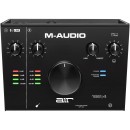
M-Audio AIR 192|4 |
VS | |||
|---|---|---|---|---|
| Analog: 2 Inputs / 2 Outputs at 192 kHz |
Channels of I/O |
Analog: 2 Inputs / 2 Outputs at 192 kHz |
Analog: 2 Inputs / 2 Outputs |
Analog: 2 Inputs / 2 Outputs at 192 kHz |
| 192 kHz / 24-Bit | Maximum Sampling Rate | 192 kHz / 24-Bit | 48 kHz / 16-Bit | 192 kHz / 24-Bit |
| 1 Preamp | Number of Microphone Inputs | 1 | 1 Preamp | 2 Preamps |
| 1x Combo XLR-1/4" TRS Balanced Mic/Line Input 1x 1/4" TS Unbalanced Hi-Z Input (Front Panel) 2x 1/4" TRS Balanced Line Output 1x 1/4" TRS Unbalanced Headphone Output (Front Panel) |
Analog Audio I/O |
1x XLR 3-Pin Balanced Mic Input 1x 1/4" TS Unbalanced Line/Hi-Z Input (Front Panel) 2x 1/4" TRS Balanced Monitor Output 1x 1/4" TRS Headphone Output (Front Panel) |
1x Combo XLR-1/4" TRS Balanced Mic/Line Input (Front Panel) 1x 1/4" TRS Balanced/Unbalanced Line/Hi-Z Input (Front Panel) 1x Stereo RCA Coaxial Unbalanced Monitor Output 1x 1/8" / 3.5 mm TRS Unbalanced Headphone Output (Front Panel) |
2x Combo XLR-1/4" TRS Balanced/Unbalanced Mic/Line/Hi-Z Input 2x 1/4" TRS Balanced Line/Monitor Output 1x 1/4" TRS Unbalanced Headphone Output |
| 1x USB-C (Class-Compliant) | Host Connection | 1x USB-C | 1x USB-B (Class-Compliant) | 1x USB-C (Class-Compliant) |
| macOS 10.8 or Later Windows 7 or Later |
OS Compatibility |
macOS Windows |
macOS 10.8 or Later Windows 7 or Later (32-/64-Bit) |
macOS 10.13 or Later (64-Bit Only) Windows 10 or Later (64-Bit Only) |
| USB Bus Power | Power Requirements | USB Bus Power, USB Power Adapter (Not Included) | USB Bus Power | USB Bus Power |
